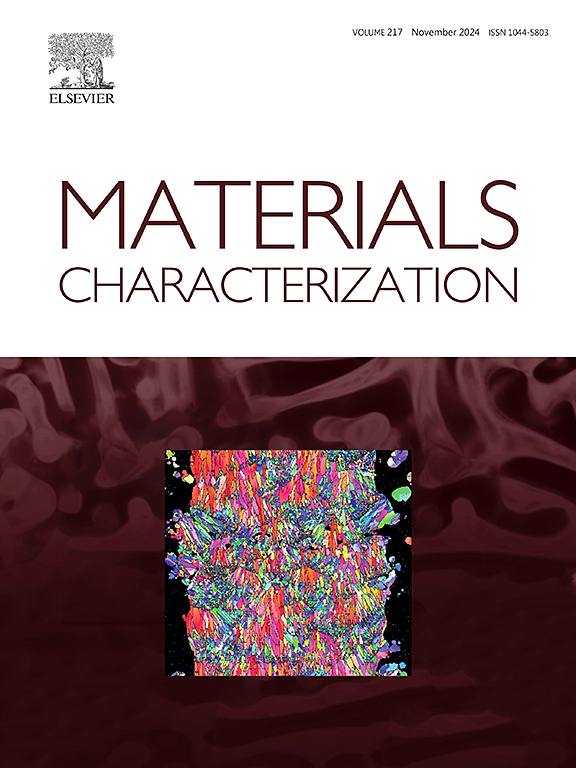定向能电弧沉积2219铝合金的偏析行为及组织演变
IF 4.8
2区 材料科学
Q1 MATERIALS SCIENCE, CHARACTERIZATION & TESTING
引用次数: 0
摘要
偏析影响晶粒内的溶质含量以及晶界处二次相的含量和分布,导致组织和性能不均匀。它还会影响定向能沉积电弧(ed -arc)重熔和后加热过程中的微观结构演变,最终影响产品在制造状态和热处理状态下的性能。本研究以2219铝合金为材料,采用d -弧成形技术制备了墙体。采用数值模拟方法计算了增材制造过程的温度场和凝固参数。分析了合金的偏析行为和显微组织特征。在铸壁中观察到宏观偏析和微观偏析。在同一层中,金属最后凝固的顶部的Cu含量高于金属最先凝固的底部。由于冷却速率较高,前几层的微偏析更为严重。随着d -弧过程的进行,层间富集的共晶通过重熔形成网状结构,同时通过Cu富集和Al3Zr成核获得更细的晶粒尺寸。随着逐层沉积过程的继续,筑壁在粗粒未熔化的层内、粗粒部分重熔的带有网络分布共晶的层内、细粒重熔的带有网络分布共晶的层间和细粒新沉积的层间交替形成。本文章由计算机程序翻译,如有差异,请以英文原文为准。
Segregation behavior and microstructure evolution of 2219 aluminum alloy by directed energy deposition-arc
Segregation affects the solute content within the grains, as well as the content and distribution of the secondary phases at grain boundaries, leading to structural and property inhomogeneity. It also influences the microstructure evolution during the remelting and post-heating in directed energy deposition-arc (DED-Arc), ultimately impacting product performance in both as-built and heat-treated states. In this study, a 2219 aluminum alloy wall was fabricated using DED-Arc. Numerical simulation was employed to calculate the temperature field of the additive manufacturing process and solidification parameters. The segregation behavior and microstructure characteristics were analyzed. Both macrosegregation and microsegregation were observed in the as-built wall. Within a single layer, the Cu content is higher at the top where the metal solidifies last, than at the bottom where it solidifies first. The microsegregation is more severe in the first few layers due to the higher cooling rate. As the DED-Arc process progresses, eutectics enriched in the interlayer form a reticular network due to remelting, while a finer grain size is achieved through Cu enrichment and Al3Zr nucleants. As the layer-by-layer deposition process continues, the as-built wall alternates between coarse-grained unmelted intralayers, coarse-grained partially remelted intralayers with network-distributed eutectics, fine-grained remelted interlayers with network-distributed eutectics and fine-grained newly deposited interlayers.
求助全文
通过发布文献求助,成功后即可免费获取论文全文。
去求助
来源期刊

Materials Characterization
工程技术-材料科学:表征与测试
CiteScore
7.60
自引率
8.50%
发文量
746
审稿时长
36 days
期刊介绍:
Materials Characterization features original articles and state-of-the-art reviews on theoretical and practical aspects of the structure and behaviour of materials.
The Journal focuses on all characterization techniques, including all forms of microscopy (light, electron, acoustic, etc.,) and analysis (especially microanalysis and surface analytical techniques). Developments in both this wide range of techniques and their application to the quantification of the microstructure of materials are essential facets of the Journal.
The Journal provides the Materials Scientist/Engineer with up-to-date information on many types of materials with an underlying theme of explaining the behavior of materials using novel approaches. Materials covered by the journal include:
Metals & Alloys
Ceramics
Nanomaterials
Biomedical materials
Optical materials
Composites
Natural Materials.
 求助内容:
求助内容: 应助结果提醒方式:
应助结果提醒方式:


